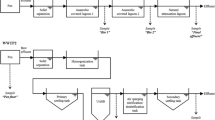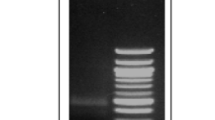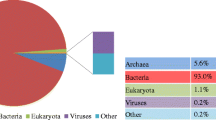Abstract
A looming global energy crisis has directly increased biomethanation processes using anaerobic digestion technology. However, much knowledge on the microbial community structure, their distribution within the digester and related functions remains extremely scanty and unavailable in some cases, yet very valuable in the improvement of the anaerobic bioprocesses. Using pyrosequencing technique based on Miseq PE 3000, microbial community population profiles were determined in an operated mesophilic expanded granular sludge bed (EGSB) reactor treating beet sugar industrial wastewater (BSIW) in the laboratory scale. Further, the distribution of the organisms in the lower, middle and upper sections within the reactor was examined. To our knowledge, this kind of analysis of the microbial community in a reactor treating BSIW is the first of its kind. A total of 44,204 non-chimeric reads with average length beyond 450 bp were yielded. Both bacterial and archaeal communities were identified with archaea predominance (60 %) observed in the middle section. Bayesian classifier yielded 164 families with only 0.73 % sequences which could not be classified to any taxa at family level. The overall phylum predominance in the reactor showed Firmicutes, Euryarchaeota, Chloroflexi, Proteobacteria and Bacteroidetes in the descending order. Our results clearly demonstrate a highly diverse microbial community population of an anaerobic reactor treating BSIW, with distinct distribution levels within the reactor.


Similar content being viewed by others
References
Alkaya E, Demirer GN (2011) Anaerobic acidification of sugar-beet processing wastes: effect of operational parameters. Biomass Bioenergy 35:32–39
Alonso RM, García MP, del Río RS (2014) Performance of up-flow anaerobic fixed bed reactor of the treatment of sugar beet pulp lixiviation in a thermophilic range. Bioresour Technol 154:305–312
Alper H, Stephanopoulos G (2009) Engineering for biofuels: exploiting innate microbial capacity or importing biosynthetic potential? Nat Rev Microbiol 7:715–723
Altschul SF, Gertz EM, Agarwala R, Schäffer AA, Yu Y-K (2009) PSI-BLAST pseudocounts and the minimum description length principle. Nucleic Acids Res 37:815–824
Angelidaki I, Ahring B, Deng H, Schmidt J (2002) Anaerobic digestion of olive oil mill effluents together with swine manure in UASB reactors. Water Sci Technol 45:213–218
Angelidaki I, Karakashev D, Batstone DJ, Plugge CM, Stams AJ (2011) Biomethanation and its potential. Methods Enzymol 494:327–351
Antoni D, Zverlov VV, Schwarz WH (2007) Biofuels from microbes. Appl Microbiol Biotechnol 77:23–35
Bagi Z, Ács N, Bálint B, Horváth L, Dobó K, Perei KR, Rákhely G, Kovács KL (2007) Biotechnological intensification of biogas production. Appl Microbiol Biotechnol 76:473–482
Bocher B, Cherukuri K, Maki J, Johnson M, Zitomer D (2015) Relating methanogen community structure and anaerobic digester function. Water Res 70:425–435
Chen S, Dong X (2005) Proteiniphilum acetatigenes gen. nov., sp. nov., from a UASB reactor treating brewery wastewater. Int J Syst Evol Microbiol 55:2257–2261
Cole JR, Chai B, Farris RJ, Wang Q, Kulam S, McGarrell DM, Garrity GM, Tiedje JM (2005) The Ribosomal Database Project (RDP-II): sequences and tools for high-throughput rRNA analysis. Nucleic Acids Res 33:D294–D296
Demirel B, Scherer P (2008) The roles of acetotrophic and hydrogenotrophic methanogens during anaerobic conversion of biomass to methane: a review. Rev Environ Sci Biotechnol 7:173–190
Gissén C, Prade T, Kreuger E, Nges IA, Rosenqvist H, Svensson S-E, Lantz M, Mattsson JE, Börjesson P, Björnsson L (2014) Comparing energy crops for biogas production–yields, energy input and costs in cultivation using digestate and mineral fertilisation. Biomass Bioenergy 64:199–210
Godon J-J, Zumstein E, Dabert P, Habouzit F, Moletta R (1997) Microbial 16S rDNA diversity in an anaerobic digester. Water Sci Technol 36:49–55
Grabowski A, Tindall BJ, Bardin V, Blanchet D, Jeanthon C (2005) Petrimonas sulfuriphila gen. nov., sp. nov., a mesophilic fermentative bacterium isolated from a biodegraded oil reservoir. Int J Syst Evol Microbiol 55:1113–1121
Gudelj I, Weitz JS, Ferenci T, Claire Horner‐Devine M, Marx CJ, Meyer JR, Forde SE (2010) An integrative approach to understanding microbial diversity: from intracellular mechanisms to community structure. Ecol Lett 13:1073–1084
Güven G, Perendeci A, Tanyolac A (2009) Electrochemical treatment of simulated beet sugar factory wastewater. Chem Eng J 151:149–159
Hughes JB, Hellmann JJ (2005) The application of rarefaction techniques to molecular inventories of microbial diversity. Methods Enzymol 397:292–308
Iza J, Palencia J, Fdz-Polanco F (1990) Waste water management in a sugar beet factory: a case study of comparison between anaerobic technologies. Water Sci Technol 22:123–130
Jeyaseelan S, Matsuo T (1995) Effects of phase separation in anaerobic digestion on different substrates. Water Sci Technol 31:153–162
Johnson DR, Goldschmidt F, Lilja EE, Ackermann M (2012) Metabolic specialization and the assembly of microbial communities. ISME J 6:1985–1991
Kendall MM, Boone DR (2006) The order Methanosarcinales. In: The prokaryotes. Springer, pp 244-256
Klocke M, Mähnert P, Mundt K, Souidi K, Linke B (2007) Microbial community analysis of a biogas-producing completely stirred tank reactor fed continuously with fodder beet silage as mono-substrate. Syst Appl Microbiol 30:139–151
Krause L, Diaz NN, Edwards RA, Gartemann K-H, Krömeke H, Neuweger H, Pühler A, Runte KJ, Schlüter A, Stoye J (2008) Taxonomic composition and gene content of a methane-producing microbial community isolated from a biogas reactor. J Biotechnol 136:91–101
Kröber M, Bekel T, Diaz NN, Goesmann A, Jaenicke S, Krause L, Miller D, Runte KJ, Viehöver P, Pühler A (2009) Phylogenetic characterization of a biogas plant microbial community integrating clone library 16S-rDNA sequences and metagenome sequence data obtained by 454-pyrosequencing. J Biotechnol 142:38–49
Liao R, Li Y, Yu X, Shi P, Wang Z, Shen K, Shi Q, Miao Y, Li W, Li A (2014) Performance and microbial diversity of an expanded granular sludge bed reactor for high sulfate and nitrate waste brine treatment. J Environ Sci 26:717–725
Liu F, Wang S, Zhang J, Zhang J, Yan X, Zhou H, Zhao G, Zhou Z (2009) The structure of the bacterial and archaeal community in a biogas digester as revealed by denaturing gradient gel electrophoresis and 16S rDNA sequencing analysis. J Appl Microbiol 106:952–966
Lu L, Xing D, Ren N (2012) Pyrosequencing reveals highly diverse microbial communities in microbial electrolysis cells involved in enhanced H 2 production from waste activated sludge. Water Res 46:2425–2434
Lübken M, Gehring T, Wichern M (2010) Microbiological fermentation of lignocellulosic biomass: current state and prospects of mathematical modeling. Appl Microbiol Biotechnol 85:1643–1652
Lynd LR, Weimer PJ, Van Zyl WH, Pretorius IS (2002) Microbial cellulose utilization: fundamentals and biotechnology. Microbiol Mol Biol Rev 66:506–577
Moeller L, Lehnig M, Schenk J, Zehnsdorf A (2015) Foam formation in biogas plants caused by anaerobic digestion of sugar beet. Bioresour Technol 178:270–277
Narihiro T, Sekiguchi Y (2007) Microbial communities in anaerobic digestion processes for waste and wastewater treatment: a microbiological update. Curr Opin Biotechnol 18:273–278
Patil SS, Kumar MS, Ball AS (2010) Microbial community dynamics in anaerobic bioreactors and algal tanks treating piggery wastewater. Appl Microbiol Biotechnol 87:353–363
Regueiro L, Veiga P, Figueroa M, Alonso-Gutierrez J, Stams AJ, Lema JM, Carballa M (2012) Relationship between microbial activity and microbial community structure in six full-scale anaerobic digesters. Microbiol Res 167:581–589
Sekiguchi Y, Takahashi H, Kamagata Y, Ohashi A, Harada H (2001) In situ detection, isolation, and physiological properties of a thin filamentous microorganism abundant in methanogenic granular sludges: a novel isolate affiliated with a clone cluster, the green non-sulfur bacteria, subdivision I. Appl Environ Microbiol 67:5740–5749
Sekiguchi Y, Yamada T, Hanada S, Ohashi A, Harada H, Kamagata Y (2003) Anaerolinea thermophila gen. nov. sp. nov. and Caldilinea aerophila gen. nov. sp. nov. novel filamentous thermophiles that represent a previously uncultured lineage of the domain Bacteria at the subphylum level. Int J Syst Evol Microbiol 53:1843–1851
Snaidr J, Amann R, Huber I, Ludwig W, Schleifer K-H (1997) Phylogenetic analysis and in situ identification of bacteria in activated sludge. Appl Environ Microbiol 63:2884–2896
St-Pierre B, Wright A-DG (2014) Comparative metagenomic analysis of bacterial populations in three full-scale mesophilic anaerobic manure digesters. Appl Microbiol Biotechnol 98:2709–2717
Thauer RK, Kaster A-K, Seedorf H, Buckel W, Hedderich R (2008) Methanogenic archaea: ecologically relevant differences in energy conservation. Nat Rev Microbiol 6:579–591
Ueki A, Akasaka H, Suzuki D, Ueki K (2006) Paludibacter propionicigenes gen. nov., sp. nov., a novel strictly anaerobic, Gram-negative, propionate-producing bacterium isolated from plant residue in irrigated rice-field soil in Japan. Int J Syst Evol Microbiol 56:39–44
UniFrac F (2010) facilitating high-throughput phylogenetic analyses of microbial communities including analysis of pyrosequencing and PhyloChip data Hamady, Micah; Lozupone, Catherine; Knight, Rob. ISME J 4:17–27
Wang B, Sui J, Liu R, Yang G, Qi P (1986) Anaerobic reactors treating beet sugar effluents. Effluent Water Treat J 26:150–162
Weiland P (2010) Biogas production: current state and perspectives. Appl Microbiol Biotechnol 85:849–860
Xia S, Duan L, Song Y, Li J, Piceno YM, Andersen GL, Alvarez-Cohen L, Moreno-Andrade I, Huang C-L, Hermanowicz SW (2010) Bacterial community structure in geographically distributed biological wastewater treatment reactors. Environ Sci Technol 44:7391–7396
Xing Y-J, Ji J-Y, Zheng P, Zhang J-Q, Ghulam A (2014) Microbial consortium and its spatial distribution in a compartmentalized anaerobic reactor. Appl Microbiol Biotechnol 98:1357–1366
Yamada T, Sekiguchi Y, Imachi H, Kamagata Y, Ohashi A, Harada H (2005) Diversity, localization, and physiological properties of filamentous microbes belonging to Chloroflexi subphylum I in mesophilic and thermophilic methanogenic sludge granules. Appl Environ Microbiol 71:7493–7503
Yang S-J, Kataeva I, Hamilton-Brehm SD, Engle NL, Tschaplinski TJ, Doeppke C, Davis M, Westpheling J, Adams MW (2009) Efficient degradation of lignocellulosic plant biomass, without pretreatment, by the thermophilic anaerobe “Anaerocellum thermophilum” DSM 6725. Appl Environ Microbiol 75:4762–4769
Ye L, Shao M-F, Zhang T, Tong AHY, Lok S (2011) Analysis of the bacterial community in a laboratory-scale nitrification reactor and a wastewater treatment plant by 454-pyrosequencing. Water Res 45:4390–4398
Zhang T, Shao M-F, Ye L (2012) 454 Pyrosequencing reveals bacterial diversity of activated sludge from 14 sewage treatment plants. ISME J 6:1137–1147
Zhao G, Ma F, Wei L, Chua H (2012) Using rice straw fermentation liquor to produce bioflocculants during an anaerobic dry fermentation process. Bioresour Technol 113:83–88
Acknowledgments
This work was supported by the National Science Fund for Distinguished Young Scholars of China (51125033) and the International Cooperating Project between China and European Countries (2014DFE90110). The authors thank the support of the State Key Laboratory of Urban Water Resource and Environment—Harbin Institute of Technology (2015DX08).
Author information
Authors and Affiliations
Corresponding author
Ethics declarations
Funding
This study was supported by the National Science Fund for Distinguished Young Scholars of China (51125033), International Cooperating Project between China and European Countries (2014DFE90110) and State Key Laboratory of Urban Water Resource and Environment—Harbin Institute of Technology (2015DX08).
Conflict of interest
The authors declare that they have no competing interests.
Ethical approval
This article does not contain any studies with human participants or animals performed by any of the authors.
Rights and permissions
About this article
Cite this article
Ambuchi, J.J., Liu, J., Wang, H. et al. Microbial community structural analysis of an expanded granular sludge bed (EGSB) reactor for beet sugar industrial wastewater (BSIW) treatment. Appl Microbiol Biotechnol 100, 4651–4661 (2016). https://doi.org/10.1007/s00253-015-7245-2
Received:
Revised:
Accepted:
Published:
Issue Date:
DOI: https://doi.org/10.1007/s00253-015-7245-2




